Class 08, 09, and 10
Diesel Shunter
These classes are variants of what must surely be the most successful design of British Railways (BR) locomotive. Known colloquially as Gronks, after the noise made whilst moving, such is the scope and longevity of the standard BR shunter that your author cannot hope to cover the entire subject — this would fill an entire website of its own. Therefore, this section aims to "scratch the surface" and focus on the type's deployment on the former Southern Region of BR, particularly the South Eastern Division; however, photographs of the type on other regions have been included simply to illustrate the earlier liveries and numbering. Your author was originally going to split each class into separate sections; however, given the historic development of the variants, combined with the fact that there was no clear numbering distinction between them pre-TOPS, it was found easier to take them as one.
During trials of a 40-ton Armstrong Sulzer diesel-electric on LMS and London North Eastern Railway (LNER) systems in 1933, it was found that this traction type could halve ordinary shunting costs associated with steam traction that undertook the same work. This included a fuel bill reduction of 75%, in addition to the fact that a single person could operate a diesel-electric shunter (or two locomotives if coupled together), compared to both a driver and fireman being required for a steam engine. The diesel-electric could also run continuously for 23 hours, with a saving in operating time of around 20% compared to steam (ref: The Sunderland Echo & Shipping Gazette, 17th July 1933). By the end of 1946, it had been found that ten diesel-electrics could be refuelled from a single oil tank wagon for a week's running, whereas the same number of steam locomotives would need 130-tons of coal, whilst also having to keep returning to their sheds in the interim for servicing (ref: Acton Gazette and West London Post, 27th December 1946).
The first examples of BR's standard diesel shunter were reported as nearing completion at Derby in September 1952, alongside the initial batch of Standard Class "4" 2-6-4 Tanks (ref: The Railway Magazine, December 1952). Originally numbered in the series starting 13000, these 0-6-0 diesel-electrics were designed at Derby to the criteria laid out by R. A. Riddles, and over 1,000 were produced. Rated at 400 Brake Horse Power (BHP) and possessing a top speed of 20 MPH (ref: The Railway Magazine, December 1952), externally the type resembled the earlier diesel shunting locomotives built by the London, Midland & Scottish (LMS) Railway prior to 1948 and those introduced by the Southern Region in 1949; these latterly became Classes 11 and 12 respectively under British Rail's TOPS numbering system.
By August 1953, twenty-five of the then new standard 13000 series 0-6-0 diesel electric shunters were in service on BR and allocated as follows:
- Western Region: 13000 to 13004
- Scottish Region: 13005 to 13009
- Southern Region: 13010 to 13014
- London Midland Region: 13015 to 13024
(Ref: The Railway Magazine, August 1953)
The Southern Region allocation given above went to Hither Green (73C) (ref: RCTS' The Railway Observer, August 1953). During the period ending 3rd October 1953, No. 13025 was completed at Derby and allocated to the Western Region (ref: The Railway Magazine, December 1953).
The early locomotives were equipped with six-cylinder engines supplied by English Electric Co. Ltd, which gave a maximum output of 400 BHP at 680 RPM; however, the design of the shunter included provision for the diesel and electrical equipment of multiple manufacturers to be installed (ref: The Railway Magazine, August 1953). The shunters were also fitted with double-reduction gears (ref: The Railway Magazine, August 1953); this set-up meant that the high speed output of the diesel engine/traction motors could be reduced to a slower output, ideal for moving heavy wagonloads in freight yards. Two traction motors were incorporated, on front and rear axles, and the double-reduction gearing gave a ratio of 23.9:1 to the wheels (ref: The Railway Magazine, August 1953). A safety feature incorporated was that of a "deadman's pedal", which had to remain depressed in order for power to be applied (ref: The Railway Magazine, August 1953).
30th July 1962

Positioned beyond the south western end of Swindon station is shunter No. D4121. This locomotive had only arrived at Swindon (82C) four months before this photograph was taken, in March 1962. Built at Horwich, it formed part of Swindon Lot No. 453 and came in the company of classmate No. D4122 (ref: RCTS' The Railway Observer, April 1962). As can be seen, wasp stripes were already a feature by then — the RCTS estimates that these started being applied in about 1960. Under TOPS, No. D4121 became No. 08891 and, by 1980, was allocated to Longsight, Manchester. The shunter was still at Longsight in July 1991, along with ten other Class 08s as part of the DCLS RCE Midland Departmental pool (ref: The Railway Magazine, July 1991). In 2004, the locomotive gained Freightliner green livery (ref: The Railway Magazine, December 2004) and, in 2006, the name "J. R. 1951-2005" was applied (ref: The Railway Magazine, August 2006) — by that time, No. 08892 was at Southampton Maritime. An overhaul on the shunter was completed in late 2022, during which it was painted into bright orange Freightliner livery, and it returned to work at the Port of Felixstowe. Also seen in the above view, approaching from the south west, is "Castle" Class No. 7003 "Elmley Castle". In the year of this picture, the Western Region well and truly waged war on steam, with the sudden withdrawal of the "King" Class, the then new diesel-hydraulics arriving in force. No. 7003 survived in service until 1964, being withdrawn from 85B in August of that year (ref: RCTS' The Railway Observer, November 1964). © David Glasspool Collection
The March 1954 edition of the RCTS' The Railway Observer noted the allocation of Nos. 13040 to 13042 to the Southern Region at Feltham (70B) from new. No. 13043 arrived at Hither Green Depot (73C) from Toton on 18th March 1954 (ref: RCTS' The Railway Observer, April 1954). Nos. 13044, 13046, 13048, and 13049 were allocated to Norwood Junction (75C) and Nos. 13045 and 13047 to Hither Green (ref: RCTS' The Railway Observer, June 1954). Further allocations followed as per the below:
- Nos. 13010, 13011, and 13012 to Eastleigh (71A) by 31st October 1954, and Nos. 13044, 13046, and 13049 to Hither Green (73C) by 31st October 1954 (ref: RCTS' The Railway Observer, December 1954).
- Nos. 13092 and 13093 to Norwood Junction (75C) in November 1954 (ref: RCTS' The Railway Observer, January 1955).
- Nos. 13097 and 13100 to Norwood Junction (75C) in January 1955 (ref: RCTS' The Railway Observer, May 1955).
- No. 13101 to Norwood Junction (75C) in February 1955 (ref: RCTS' The Railway Observer, May 1955).
- Nos. 13217 to 13221 to Norwood Junction (75C) in April 1955 (ref: RCTS' The Railway Observer, May 1955).
As of February 1955, the following Southern Region sheds were responsible for the maintenance of diesel shunters, which included the allocation of the following locomotives from the 13000 series:
- Hither Green (73C): Nos. 13043, 13044, 13045, and 13046.
- Norwood (75C): 13047, 13048, 13049, 13095*, 13096*, 13097*, 13098*, 13099*, 13100*, and 13101*.
- Eastleigh (71A): 13010, 13011*, 13012, 13013*, and 13014*.
- Feltham (70B): 13040, 13041, and 13042
- Brighton (75A): 13092*, 13093*, and 13094*
(Ref: RCTS' The Railway Observer, April 1955)
*Locomotives withdrawn before TOPS.
In June 1955, Darlington-built Nos. 13222, 13224, and 13225 were allocated to Norwood Junction (75C) (ref: RCTS' The Railway Observer, July 1955); Nos. 13223 and 13226 — also Darlington products — were allocated to Norwood Junction in the following month (ref: RCTS' The Railway Observer, July 1955). In September 1956, Derby-built Nos. 13270, 13271, 13272, and 13274 were allocated to Hither Green (73C) (ref: RCTS' The Railway Observer, November 1956).
The original livery applied to the first examples built was all-over black with an early Cycling Lion BR crest centrally-positioned on each body side. In the August 1956 edition of the RCTS' The Railway Observer, it was reported that diesel shunters — starting with No. 13260 — had begun appearing in a then new livery: the body was painted in unlined Brunswick Green, the frames black, and the buffer beams and connecting rods red. The same publication noted that Derby-built No. 13260 was allocated to Swindon in June 1956. The British Railways "late" crest, seen in the below picture of No. D4164, was introduced in the same year and the first locomotive to wear it was Britannia Class 4-6-2 No. 70016 Ariel (ref: The Railway Magazine, August 1956).
Darlington-built Nos. D3459 and D3460 were allocated to the Southern Region in June 1957 (ref: RCTS' The Railway Observer, July 1957); this was later confirmed to be at Hither Green (73C) (ref: RCTS' The Railway Observer, August 1957). Darlington-built Nos. D3461 and D3462 were allocated to the Southern Region in June 1957; Nos. D3463, D3464, D3465, and D3466 — also of Darlington Works — arrived in the following July and all six went to Hither Green (ref: RCTS' The Railway Observer, August 1957). Darlington-built Nos. D3467, D3468, D3469, D3470, D3471, and D3472 were sent to Hither Green from new (ref: RCTS' The Railway Observer, September 1957).
1967
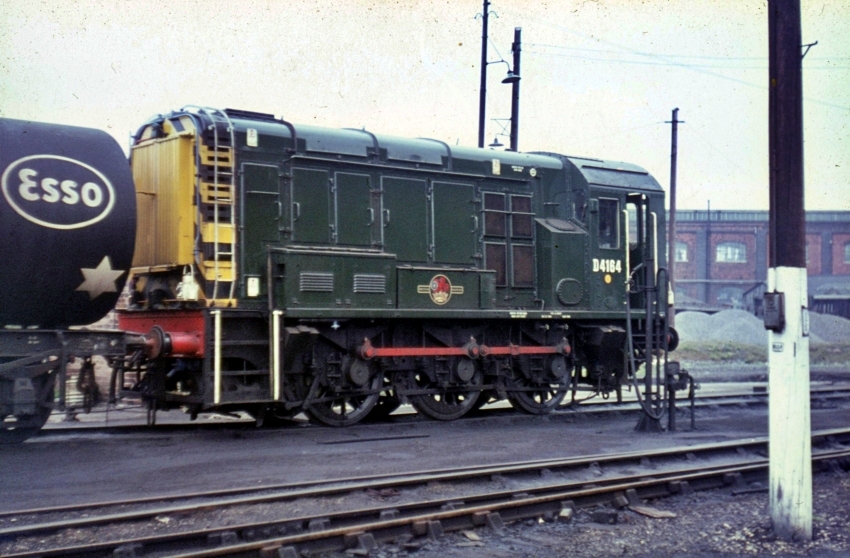
Swindon once again, but this time with No. D4164 to illustrate the period livery in a splendid colour shot. Given the colour scheme, number, and location, your author estimates this photograph to have been taken in 1967: in the period to 8th May of that year, the locomotive was reallocated to 82C (ref: The Railway Magazine, July 1967). No. D4164 was renumbered 08934 under TOPS (ref: The Railway Magazine, September 1974) and, by 2002, was based at Willesden with Virgin West Coast. From there, the shunter transferred to Alstom (The Railway Magazine, April 2002); then, in 2010, transferred from Alstom's pool of "Traincare" locomotives based at Stonebridge Park, Wembley, to GB Railfreight at Whitemoor Yard, Cambridgeshire (ref: The Railway Magazine, January 2011). As late as June 2022, No. 08934 was still at Whitemoor Yard, albeit out of use. © David Glasspool Collection
Off-Southern
Your author thought a brief diversion from the Southern Region would be appropriate, just to cover the other variants of the standard BR shunter for the sake of completeness.
In February 1955, the first of BR's 0-6-0 13000 series diesel-electric shunters that were not fitted with an English Electric engine nor electrical equipment — No. 13152 — was delivered new to Immingham (ref: RCTS' The Railway Observer, March 1955). Electrical equipment was supplied by British Thomson-Houston, the engine fitted — a Lister-Blackstone Type ERT6 — was stated at the time as being rated at 350 BHP at 750 RPM, and the mechanical parts for this locomotive were made at Darlington (ref: RCTS' The Railway Observer, April 1955). Another fourteen shunters, Nos. 13153 to 13166, were scheduled to be built at Darlington with this equipment and were bound for the Eastern Region (ref: RCTS' The Railway Observer, March 1955). Compared to the English Electric locomotives, this batch had a short working life, presumably because they fell foul to a policy of standardisation. In the May 1968 edition of The Railway Magazine, it was revealed that poor old Nos. D3153, D3154, D3161, D3163, and D3166 were spotted on 8th March of that year in C. P. Booth's scrapyard, Rotherham. The last examples of the type in service, Nos. D3162 and D3164, were withdrawn from the London Midland Region during the period to 2nd December 1967 (ref: The Railway Magazine, February 1968), and so became extinct this small subclass of fifteen shunters.
At this stage, it is worth touching upon D-prefix numbers. This classification system was announced by BR in 1957 and involved using the prefix "D" on all new main line diesel locomotives and new and existing diesel shunters (ref: RCTS' The Railway Observer, May 1957). For example, shunter No. 13000 became D3000.
Continuing the theme of non-standard diesel-electric shunters, Nos. 13117 to 13126 were scheduled to be constructed at Derby for the London Midland Region, equipped with Crossley engines and traction equipment supplied by Crompton Parkinson (ref: RCTS' The Railway Observer, March 1955). The last of this ten-strong fleet of shunters — Nos. D3117, D3118, D3119, D3120, and D3125 — were withdrawn from the London Midland Region in July 1967 (RCTS' The Railway Observer, February 1968).
Diesel-electric Nos. 13137 to 13151 were ordered with Blackstone engines and traction equipment supplied by the General Electric Company (GEC), construction being carried out at Darlington and the allocation going to the North Eastern Region (ref: RCTS' The Railway Observer, March 1955). Originally designated Class D3/4, these shunters were what later became Class 10 in 1968. In total, 146 units of this variant were built, the remainder being in the following series: D3439 to D3453; D3473 to D3502; D3512 to D3651; D4049 to D4094 (ref: The Railway Magazine, March 1996). Searching through copies of the RCTS' The Railway Observer magazines for the period, it appears that most of these went to the Eastern Region from new. The last three Class 10 shunters in service, Nos. 4066, 4073, and 4079, were withdrawn from Immingham (40B) in June 1972 (ref: RCTS' The Railway Observer, September 1972), and your author has not yet found any connections between this variant and the Southern Region.
October 1966
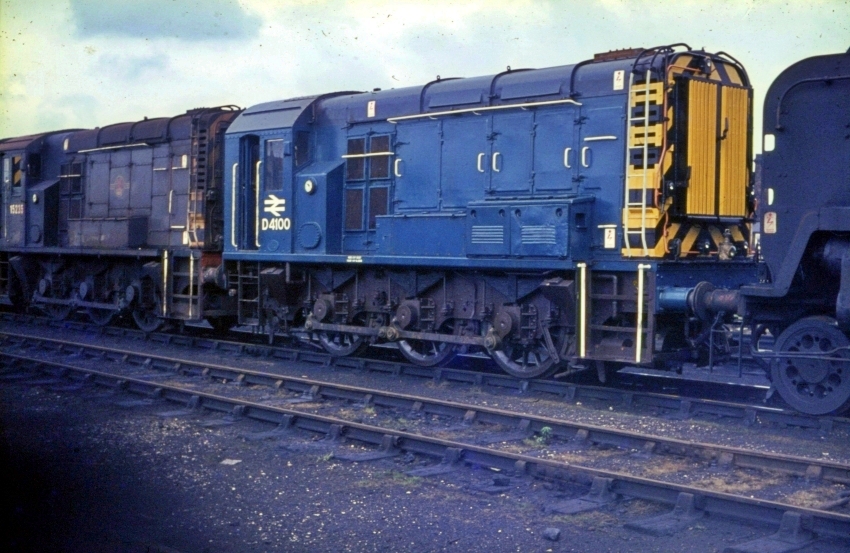
No. D4100 is seen ex-works at Eastleigh in the then new BR blue colours, but with pre-TOPS number. An interesting livery variation here is the blue of the front buffer beam. The shunter was sandwiched in-between Bulleid shunter No. 15235 (latterly Class 12) — wearing BR Green with "late" crest — and a rebuilt version of one of the same engineer's Pacific steam locomotives. The April 1966 edition of The Railway Magazine had No. D4100 as being allocated to Ashford (73F); the September 1967 edition of the same publication noted a reallocation to 70B. In March 1952, a new No. 15235 was noted as being allocated to Norwood Junction; for the period ending 9th June 1969, The Railway Magazine (August 1969) gave its reallocation as being to Hither Green (73C). Under TOPS, No. D4100 became No. 09012. © David Glasspool Collection
Back to Southern
In February 1959, Darlington-built Nos. D3665 and D3666 were allocated to the Southern Region at Salisbury (72B) (ref: RCTS The Railway Observer, March 1959). In the same month, Darlington-built Nos. D3667 and D3668 were delivered to Eastleigh (71A), and No. D3669 to Norwood Junction (75C); in March 1959, No. D3670 was allocated to Ashford (73F) and No. D3671 to Hither Green, both having been built at Darlington (ref: RCTS The Railway Observer, April 1959). These locomotives differed from the earlier builds so far covered: they were geared to attain a top speed of 27 MPH (the figure given in the Ian Allan ABC series; some other sources show 27.5 MPH), as opposed to 15 MPH and 20 MPH (both figures are given in the Ian Allan British Rail Motive Power Combined Volume of 1978). The higher top speed made it practical for the type to venture out onto the main line, slotting in-between passenger services, and an example of such operation can be seen in the picture on this page of No. 09019 running through Newington in Kent.
In April 1959, more of the 27 MPH shunter variant in the form of Darlington-built Nos. D3719, D3720, and D3721, were delivered to Hither Green (ref: RCTS' The Railway Observer, June 1959).
In the September 1959 edition of the RCTS' The Railway Observer publication, it was noted that Diesel-Electric shunters (bar Nos. 15201 to 15203) had been authorised to work over the East Kent line in-between Shepherdswell and Tilmanstone Colliery. The presumption was that this would lead to the demise of the incumbent O1 Class 0-6-0 steam locomotives from that line.
In September 1961, shunter No. D4099 went to Hither Green (73C) new, and No. D4100 to Ashford (73F), both having been built at the ex-LMS Horwich Works, Lancashire (ref: RCTS The Railway Observer, November 1961). In the following October, Nos. D4101 and D4102 were noted as having been delivered to the Southern Region, but not yet officially allocated (ref: RCTS The Railway Observer, November 1961); both are shown allocated to Ashford (73F) in the Ian Allan ABC Loco Shed Book, current to 30th January 1963 for the Southern Region. In October 1961, Horwich-built shunter Nos. D4103 and D4104 were allocated to Norwood Junction (75C) (ref: RCTS The Railway Observer, December 1961), the last 27 MPH diesel-electric shunters to be allocated to the Southern Region from new. The remaining ten shunters, Nos. 4105 to 4114, were allocated from new to the London Midland Region: Nos. D4105 to D4109 emerged from Horwich during the four weeks ended 2nd December 1961 (ref: The Railway Magazine, February 1962); Nos. D4110 to D4112 appeared from the same works during the four weeks ended 30th December 1961 (ref: The Railway Magazine, March 1962); and finally, Nos. D4113 and D4114 were completed at Horwich in the four weeks ended 27th January 1962 (ref: The Railway Magazine, April 1962).
An area which is unclear to the author is that of engine BHP of the BR standard 0-6-0 diesel-electric shunter. In the earliest editions of The Railway Magazine and the RCTS' The Railway Observer, these locomotives are attributed to a power rating of 400 BHP. This same rating is also given in the renowned Ian Allan ABC British Railways Locomotive books of the era, up to and including the Summer 1962 edition. However, from the Winter 1962/1963 ABC edition onwards, that power rating seemingly disappeared without trace and, thereafter, 350 BHP was given. The following is remarked in the Summer 1962 edition:
Engines D3000-D3336 were originally numbered 13000-13336 and are being renumbered as they are overhauled.
With this in mind, were the original engines de-rated from 400 BHP to 350 BHP during overhaul? At present, your author can only speculate.
In the September 1962 edition of the RCTS' The Railway Observer, it was remarked that, apparently, all diesel shunters on the Western Section of the Southern Region were maintained at Hither Green.
October 1983

Class 09 No. 09008 is seen leading a line of 0-6-0 diesel-electric shunters at Chart Leacon; Nos. 09023 and 08811 are possibly two of the other locomotives here. By summer 1991, No. 09008 was part of a Trainload Metals pool of shunters based at Tinsley (ref: The Railway Magazine, 1991). In 2011, after being in EWS' pool of stored locomotives, No. 09008 was moved to Barrow Hill roundhouse (ref: The Railway Magazine, April 2011) for component recovery prior to scrapping. Chart Leacon Depot closed in 2014 and the buildings were demolished by Network Rail contractor "Balfour Beatty" in August 2020 (ref: Network Rail Media Centre, 28th August 2020). © David Glasspool Collection
Engine Shed Closures and Shunter Reallocations
What of the fate of those SR sheds listed in 1955 as being maintenance depots for diesel shutters? On and from 6th January 1964, Norwood Junction engine shed was closed to steam. It was noted that it continued to be used by diesel locomotives beyond that date, but some of its diesel shunter allocation was in the process of being transferred to Selhurst Electric Depot for maintenance (ref: RCTS' The Railway Observer, April 1964).
In April 1964, it was rumoured that Ashford's (73F) allocation of diesel locomotives would be transferred later that year to Chart Leacon Depot, allowing the engine shed to be closed (ref: RCTS' The Railway Observer, April 1964) — as one of the photographs on this page attests, this transpired to be a reality. The 73F code of the steam shed persisted beyond its demise and was used by Chart Leacon; the latter changed to two-letter code AF in 1973 in preparation for the Total Operations Processing System (TOPS) (ref: The Railway Magazine, August 1973).
The next depot to go was Brighton: on and from 15th June 1964, all regular steam workings in the area ceased and the engine shed was closed to steam traction (ref: RCTS' The Railway Observer, August 1964). Diesels were reported as still using the shed after that date, but their transfer to Lovers' Walk Electric Depot was stated to be on the horizon (ref: RCTS' The Railway Observer, August 1964). The shed code 75A was used after closure, being applied to Lovers' Walk Depot until the latter was re-designated BI in 1973 (ref: The Railway Magazine, August 1973).
At Eastleigh, dedicated stabling for diesel traction had started to be developed in the late 1950s. On 16th September 1957, a fleet of two-carriage 500 HP diesel-electric multiple units (DEMU) came into service on a series of SR routes in Hampshire (ref: The Railway Magazine, December 1957). In connection with this, a then new diesel depot was commissioned at Eastleigh for the maintenance and refuelling of these units (ref: The Railway Magazine, December 1958), which was situated immediately south east of the steam shed. Based on period photographs your author has seen, the depot building housed DEMU stock only, and not Eastleigh's resident diesel shunters. However, in the September 1965 edition of The Railway Magazine, it was reported that new facilities for diesel locomotives were being erected, which included the extension of the existing DEMU building. This extension is shown in the early 1970s photograph below, with both main line and shunter diesels in evidence. Eastleigh Shed survived until the end of SR steam on 9th July 1967.
Originally coded 71A, Eastleigh had been re-designated 70D on 30th September 1963 when the Eastleigh District was disbanded and brought under Nine Elms (ref: The Railway Magazine, January 1964). The 70D code was used beyond the end of steam for the depot's diesel and electric allocation until being replaced by EH in 1973 (ref: The Railway Magazine, August 1973). As of a roster that came into effect on 5th May 1969, Classes 08, 09, and 12 shunters based at Eastleigh covered as far as Basingstoke, Redbridge, Northam, Fratton, and Salisbury (ref: RCTS' The Railway Observer, July 1969).
Early 1970s
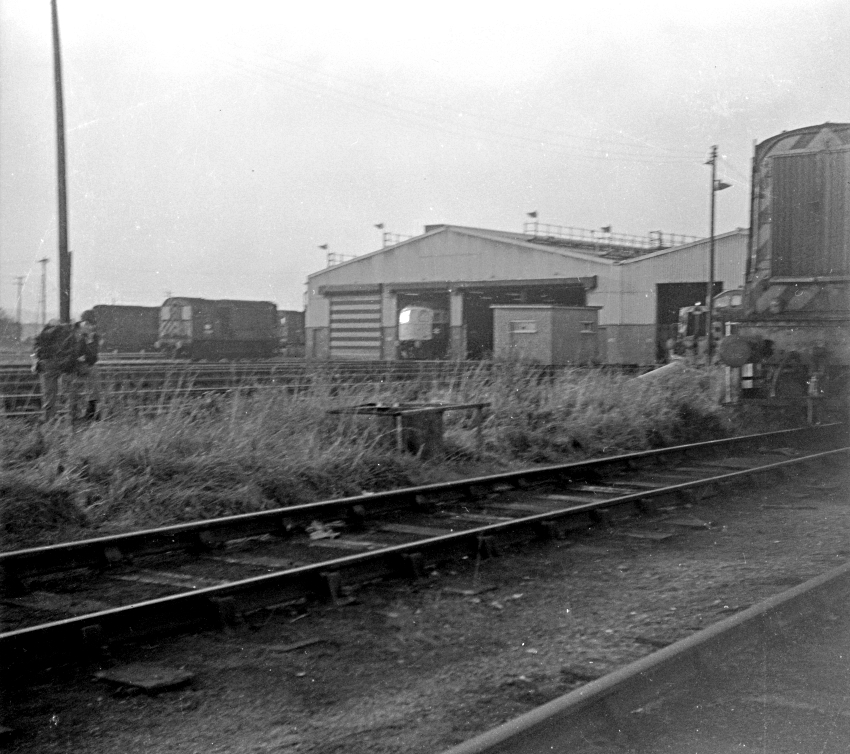
A northward view captures Eastleigh Diesel Depot, which was originally brought into use to service Hampshire/Berkshire DEMUs, and later extended to accommodate main line diesels and shunters. A Class 33 and Class 07 shunter are in evidence, as are a trio of diesel-electrics of the Class 08/09 outline. The former site of the steam shed was directly behind the depot. © David Glasspool Collection
Feltham (70B) shed closed to steam at the beginning of 1967 and officially became a diesel depot under the control of the Civil, Mechanical & Electrical Engineering (CM&EE) department of the SR (ref: RCTS' The Railway Observer, March 1967). The former steam shed was used to house diesel locomotives thereafter, official closure finally being scheduled for 5th January 1969; however, an organised visit by the RCTS on that day revealed that there was still plenty of motive power on site (ref: RCTS' The Railway Observer, March 1969). The former steam shed was being used to house a Class 33 (No. 6541) and two Electro-Diesels (Nos. E6016 and E6020); five diesel shunters — Nos. 4100, 4102, 4103, 4104, and 4114, which later became Nos. 09012, 09014, 09015, 09016, and 09026 respectively — were noted as being in a "new servicing shed", and No. 3459 (later No. 08374) was in the fuel shed. Additionally, the marshalling yard was noted at the time as being worked by pilot No. 3042 (later Class 08 No. 08030) (ref: RCTS' The Railway Observer, March 1969). However, by the depot code revisions of 1973, Feltham had disappeared from lists.
As for Hither Green, it was reported in the September 1961 edition of the RCTS' The Railway Observer magazine that the shed no longer had any steam duties, but still had facilities to service visiting engines, and "C" Class Nos. 31682, 31686, 31689, 31690, and 31691 remained allocated for special workings. As of the 1963 edition of the Ian Allan ABC Loco Shed Book, current to 11th November of that year, eight 0-6-0 diesel-electric shunters of the D3000 series were allocated to Hither Green: D3097, D3098, D3099, D3466, D3467, D3468, D3472, and D3665. When the depot was re-coded from 73C to HG in 1973, it retained a complete six-road engine shed with water tank (partially demolished in 1994) and operational turntable.
7th June 1986
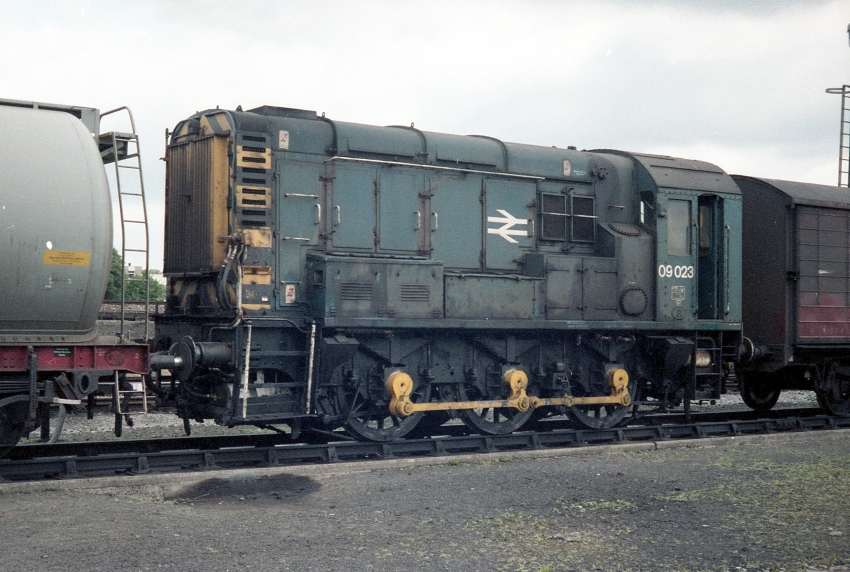
No. 09023 is seen at Chart Leacon Depot. Like No. 09008 seen above, by summer 1991 No. 09023 had also became part of a fleet of shunters based at Selhurst. In 1995, No. 09023 was reported as being at Selhurst awaiting scrapping (The Railway Magazine, March 1995). Evidently, No. 09023 was given a reprieve, because it was at Old Oak Common the following year, Norwood Junction in 1997, and by 2000 had become part of a pool of EWS shunters allocated to the North West. By March 2012, No. 09023 was sitting in the scrapyard at EMR Kingsbury, Tamworth, Staffordshire. © David Glasspool
Arrows of Indecision and TOPS
An exhibition named The New Face of British Railways was held at the Design Studio, London, from 4th to 23rd January 1965 (ref: The Railway Magazine, February 1965). The purpose of the event was to unveil a then new corporate identity for British Railways, which included a shortened name — British Rail — an "arrow" logo, and a complete livery change. One of the first 350 HP 0-6-0 diesel-electric shunters to receive the corporate blue livery was No. D3284 (later 08214), which was noted in the October 1966 edition of The Railway Magazine as being in the process of being repainted at Eastleigh Works on 9th August of that year. Even after the deployment of a standard livery, there were still numerous variations between class members — such as red, yellow, and even blue buffer beams — that this subject could fill a book in itself. The pictures in this section aim illustrate some of these differences.
In 1968, a then new numerical classification system was introduced by BR for diesel and electric locomotives, designed around computerised accounting records. The class numbers for diesels were arranged in a way to roughly indicate haulage power, in ascending order (ref: The Railway Magazine, September 1968).
Class 08: D3000 to D3116; D3127 to D3136; D3167 to D3438; D3454 to D3472; D3503 to D3611; D3652 to D3664; D3672 to D3718; D3722 to D4048; D4095 to D4098; D4115 to D4186; D4191 to D4192 (992 units)
Class 09: D3665 to D3671; D3719 to D3721; D4099 to D4114 (26 units)
Class 10: D3137 to D3151; D3439 to D3453; D3473 to D3502; D3612 to D3651; D4049 to D4094 (146 units)
(Ref: RCTS' The Railway Observer, September 1968)
The first diesel locomotives to be renumbered in the TOPS series were Class 45 Nos. 96 and 51, which became Nos. 45101 and 45102 respectively; this had been completed by 1st April 1973 (ref: RCTS' The Railway Observer, May 1973). The first Class 08 shunter to be renumbered in the TOPS series was No. 08617 (formerly No. 3784), which occurred in September 1973 (ref: RCTS' The Railway Observer, November 1973); it was followed by Nos. 08133, 08466, 08766, 08838, and 08861 in the following October (ref: RCTS' The Railway Observer, December 1973). The final part of the TOPS computerised freight information and transit control system went live nationwide on 27th October 1975 and was designed to keep track of BR's 180,000 traffic wagons (ref: The Railway Magazine, December 1975).
6th August 1987
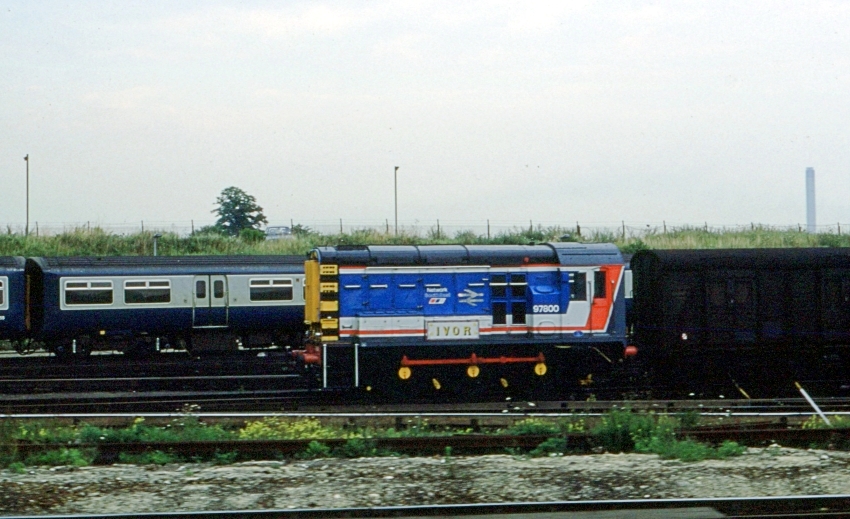
In the colourful "Toothpaste" livery of BR sector Network SouthEast, Class 08 No. 97800 "Ivor" is depicted at Slade Green Depot, in-between the former engine shed (out of view left) and the heavy maintenance building (out of view right). Behind is a Class 455/8 unit from the South Western Division, which had come empty stock from Wimbledon and was not a type deployed on the North Kent Line. "Ivor" had been the shunter at Slade Green Depot since at least 31st December 1976 (ref: The Railway Observer, March 1977) and was transferred to Southern Region departmental stock in January 1979 (ref: RCTS' The Railway Observer, June 1979). Originally No. 08600, "Ivor" was renumbered to 98800 in May 1979, but by 10th of the following month this had been changed to 97800 (ref: RCTS' The Railway Observer, August 1979). 97xxx was the standard numbering series for locomotives in departmental use on BR. No. 97800 was present at the London & Greenwich Railway's 150th Anniversary celebrations at Cannon Street over the weekend of 23rd and 24th of August 1986, by which time it had been repainted from departmental blue and red to Network SouthEast "Toothpaste" colours. In the March 1990 edition of "The Railway Magazine", it was reported that No. 97800 had been renumbered back to its original ID of 08600, having left departmental stock. In November 1991, Motor Luggage Van No. 931095 (formerly No. 9005) became the pilot at Slade Green Depot (ref: The Railway Magazine, January 1992), presumably as a replacement for No. 97800. © David Glasspool Collection
Class 08/09 Southern Region Allocations: 31st December 1976
- Ashford (AF): 08155, 08156, 08157, 08380, 08381, 08383, 08385, 08414, 08650, 08811, 08830, 08833, 08847, 08892, 09008, 09011, 09013, 09018, 09019, and 09022.
- Bournemouth (BM): 09024, 09025, and 09026.
- Eastleigh (EH): 08028, 08030, 08031, 08150, 08151, 08200, 08201, 08202, 08203, 08204, 08323, 08387, 08831, 08845, 08854, 08929, and 08933.
- Hither Green (HG): 08374, 08375, 08378, 08653, 08760, 09004, 09006, 09007, and 09010.
- Slade Green (SG): 08600.
- Selhurst (SU): 08152, 08154, 08158, 08376, 08379, 08384, 08642, 08648, 08655, 08837, 09001, 09002, 09003, 09005, 09009, 09012, 09014, 09015, 09016, 09017, 09020, 09021, and 09023.
(Ref: RCTS' The Railway Observer, March 1977)
In the February 1981 edition of the RCTS' The Railway Observer, it was reported that all diesel shunters had been transferred away from Hither Green, making it the first depot with an allocation of diesels, but no shunters. In the January 1986 edition of the same publication, it was reported that Hither Green had lost its entire locomotive allocation and was due to close. This transpired not to be the case: the first Class 60 locomotive handed over to BR at Brush Traction's Loughborough Works — No. 60001 — on 30th June 1989 was noted as wearing a Hither Green Depot logo (ref: The Railway Magazine, October 1989).
3rd March 1991
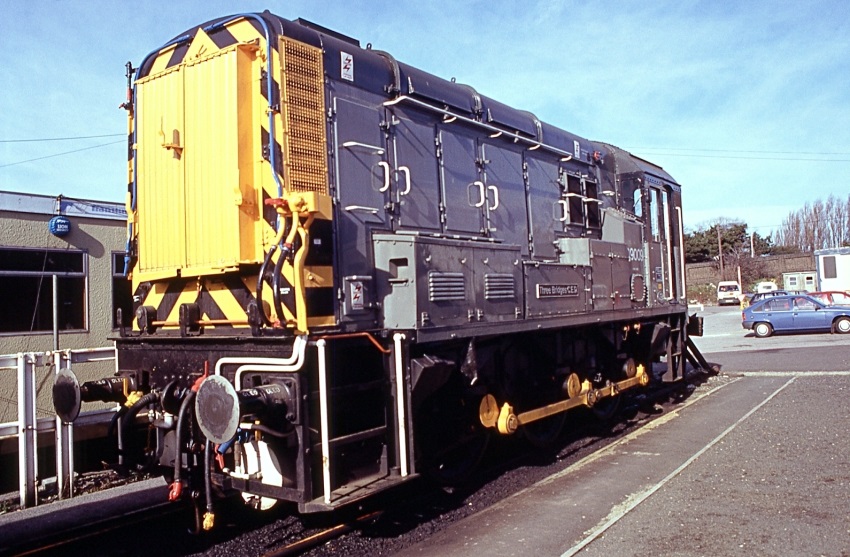
No. 09009 is seen at Norwood Junction, at a time when it was allocated to nearby Selhurst Depot for departmental use. The locomotive had acquired the name "Three Bridges C.E.D." in August 1990 (ref: RCTS' The Railway Observer, November 1990). By 2004 she was allocated to Old Oak Common (ref: RCTS' The Railway Observer, July 2004) and in August of that year was noted at Stewarts Lane (ref: The Railway Magazine, August 2004). In February 2018, No. 09009 was noted as working at Miles Platting Tarmac sidings, Manchester (ref: The Railway Magazine, April 2018). © David Glasspool Collection
Another Off-Southern Diversion: Class 13
On 12th July 1965, the first freight trains started using a then new marshalling yard at Tinsley, opened by British Railways' Eastern Region (ref: The Railway Magazine, August 1965). Tinsley Yard was officially opened by Lord Beeching on 29th October 1965 as part of a £10 million scheme to modernise and rationalise freight in and around Sheffield (ref: The Retford, Gainsborough, and Worksop Times, 29th October 1965). The yard used the concept of "hump shunting": this meant that wagons were marshalled into sidings by gravity. Wagons would be pushed up a gradient by a pilot locomotive to the summit of a "hump"; then, on the other side, gravity would take care of the work as the wagons descended into their designated sidings. Small hydraulic rams affixed to the rails were used to slow wagons' momentum.
Hump shunting was a well-established practice from steam days. Prior to dieselisation, tank engines with eight-coupled wheels of up to 100 tons in weight were used as pilots in these yards (ref: The Railway Magazine, March 1966). However, their replacements were in the form of 0-6-0 350 HP diesel-electric shunters half their weight, handling increasingly heavier loads, and so the issue of inadequate adhesion arose. Rather than develop a small non-standard class of locomotive dedicated to hump shunting at Tinsley, six existing 0-6-0 diesel-electric shunters were selected for conversion to this role.
The transformation at Darlington Works involved permanently coupling the locomotives in pairs: one shunter became the "Master" unit, the other the "Slave". The "Master" unit was from where the driver controlled the paired locomotives: its cab was fitted with signalling equipment, radio telephone, and an electronic speedometer, in addition to multiple controls to operate the "Slave" unit (ref: The Railway Magazine, March 1966). To aid visibility of the driver, the cab of the "Slave" unit was removed and, in its place, an open footplate with waistline sides and rear maintained.
The shunters paired together were as follows:
- D4188 (Master) + D3698 (Slave): D4500
- D4190 (Master) + D4189 (Slave): D4501
- D4187 (Master) + D3697 (Slave): D4502
In 1968, when the numerical classification system was introduced by BR, the three pairs became Class 13. Subsequent renumbering under TOPS in 1974 resulted in the following revised identities:
- D4500 to 13003: withdrawn January 1985 (ref: RCTS' The Railway Observer, March 1985)
- D4501 to 13001: withdrawn January 1985 (ref: RCTS' The Railway Observer, March 1985)
- D4502 to 13002: withdrawn June 1981 (ref: RCTS' The Railway Observer, September 1981)
7th February 1980
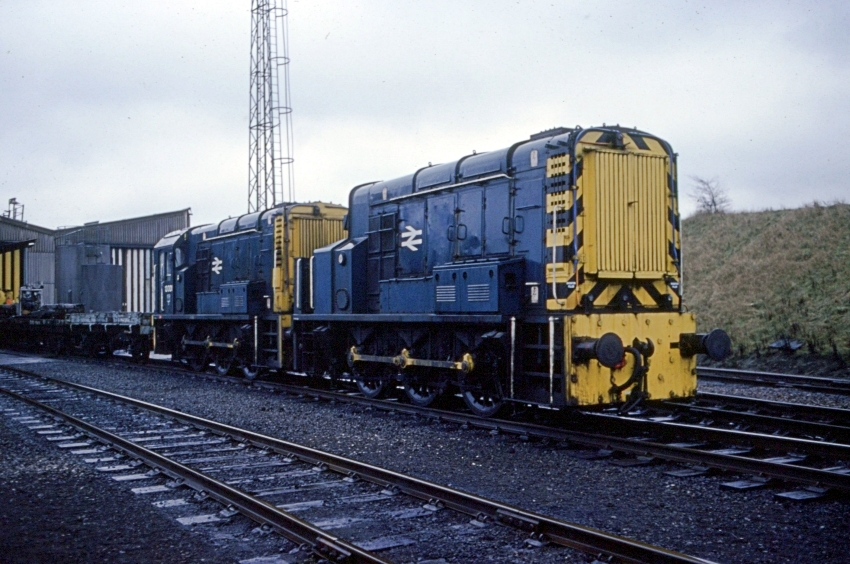
The extended buffer beam and lack of a cab on the "slave" unit are obvious in this view of Class 13 No. 13001 at Tinsley. The pairs of diesels of this small subclass were not always coupled in the formation seen above: in the earliest years, back-to-back was not unheard of. © David Glasspool Collection
Cut-Down Cabs
In the October 1984 edition of the RCTS' The Railway Observer magazine, it was reported that Class 08 No. 08259 had been altered by reducing the height of the cab. This was to enable the locomotive to avoid a series of low obstructions on the Cwm Mawr branch line in South Wales. The locomotive had been officially withdrawn from operating stock by this time, but was noted as working under its own power from Llanelli. It was speculated that two more Class 08 diesels would be similarly modified, and their deployment on the branch would allow the withdrawal of the incumbent Class 03s. Nos. 08203 and 08592 were subsequently modified with low cab roofs (ref: RCTS' The Railway Observer, June 1985). Nos. 08259, 08203, and 08592 were renumbered to 08992, 08991, and 08993 respectively (ref: RCTS' The Railway Observer, July 1985). Two further Class 08s were similarly treated: Nos. 08642 and 08687 which, as a result, were renumbered in September 1987 to Nos. 08994 and 08995 respectively (ref: RCTS' The Railway Observer, November 1987).
16th July 2016

In ex-works condition, cut-down cab No. 08993 is seen outside the locomotive depot at Haworth, West Yorkshire, on the Keighley & Worth Valley Railway (KWVR). Previously numbered 08592 under TOPS, she became No. 08993 in 1985. In the October 2015 edition of The Railway Magazine, No. 08993 was noted as sold to the KWVR. © David Glasspool Collection
Sectorisation and Privatisation
During 1992/1993, seven Class 08 shunters were converted to Class 09/1 and five to 09/2:
- Nos. 08833 to 09101 (ref: RCTS' The Railway Observer October 1992).
- Nos. 08832 to 09102 (ref: RCTS' The Railway Observer December 1992).
- Nos. 08421 to 09201, week ending 7th November 1992 (ref: RCTS' The Railway Observer January 1993).
- Nos. 08717 to 09204 , week ending 7th November 1992 (ref: RCTS' The Railway Observer January 1993).
- Nos. 08732 to 09202 , week ending 7th November 1992 (ref: RCTS' The Railway Observer January 1993).
- Nos. 08781 to 09203 , week ending 7th November 1992 (ref: RCTS' The Railway Observer January 1993).
- Nos. 08620 to 09205 week ending 4th December 1992 (ref: RCTS' The Railway Observer February 1993).
- Nos. 08766 to 09103 week ending 4th December 1992 (ref: RCTS' The Railway Observer February 1993).
- Nos. 08749 to 09104 week ending 2nd January 1993 (RCTS' The Railway Observer, March 1993).
- Nos. 08835 to 09105 week ending 2nd January 1993 (RCTS' The Railway Observer, March 1993).
- Nos. 08759 to 09106 week ending 27th March 1993 (RCTS' The Railway Observer, May 1993).
- Nos. 08845 to 09107 period ending 17th July 1993 (RCTS' The Railway Observer, September 1993).
These conversions had a 27 MPH top speed. The Class 09/1 and Class 09/2 variants had 110 Volts and 90 Volts electrical equipment respectively (ref: British Railways Locomotives & Coaching Stock 1994, Platform 5, Peter Fox).
As of spring 1991, the following departmental pools comprised Southern Region-allocated Class 08/09 shunters.
- Eastleigh Works (DBMS, Departmental, Shunters, BRML): Nos. 08642 and 08892
- Selhurst (DCSB, Departmental, RCE Southern, Shunters): 08854, 09003, 09005, 09006, 09007, 09009, 09010, 09012, 09014, 09016, 09020, and 09023.
- Ashford (DCSC: Departmental, RCE Southern, Shunters): 08600, 08637, 08649, 08922, 08940, 08950, 09002, 09011, 09018, 09019, 09021, 09022, and 09024.
- Eastleigh (DCSD: Departmental, RCE Southern, Shunters): 08760, 08831, 08845, 08847, 08933, 09004, 09025, and 09026.
(Ref: The Railway Magazine, July 1991)
15th June 1991
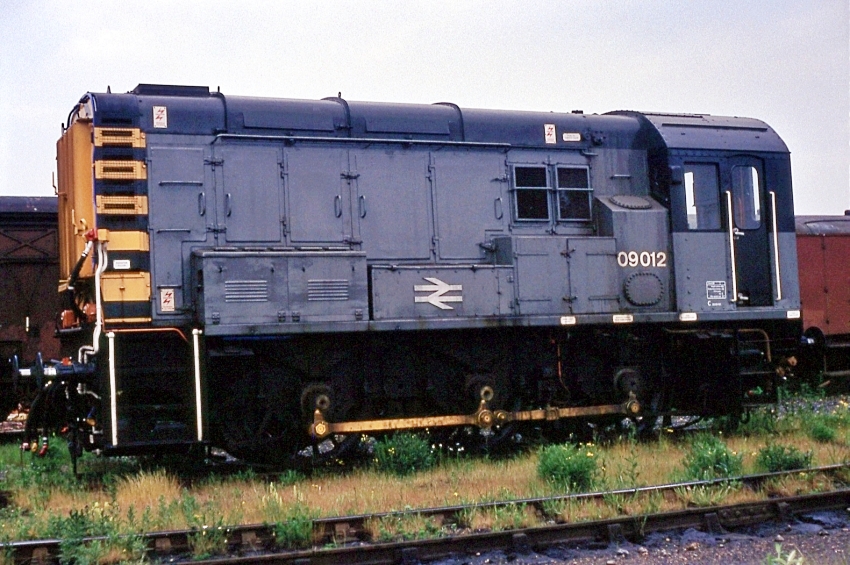
Although officially allocated to Selhurst at the time of this photograph, No. 09012 is seen at Hoo Junction wearing BR Departmental Grey. By 1996, the shunter had moved to Didcot. In the period to 8th October 2010, No. 09012 moved to Barrow Hill, having been sold to the Harry Needle Railroad Company (HNRC) after being in DB Schenker's pool of locomotives that were stored unserviceable (WNXX) (ref: RCTS' The Railway Observer, November 2010). In the period ending 1st March 2013, No. 09012 was sold by HNRC for preservation (ref: RCTS' The Railway Observer, April 2013) and, today, is based on the West Somerset Railway. © David Glasspool Collection
No. 08921 has the distinction of being the first Class 08 to be painted into the Red and Gold livery of private operator English, Welsh & Scottish Railway (EWS) (ref: The Railway Magazine, October 1996). EWS was a brand of a consortium by the name of North and South Railways, the latter led by US-based Wisconsin Central, which took over most of BR's freight operations at privatisation (Freightliner being a notable exception, having been the subject of a management buyout).
As of October 2003, the following Class 08/09 Shunter Duty locations and pools existed on the former Southern Region:
- Pool WSAS: EWS East Anglia, London and South East Class 08/09 Old Oak Common.
- Eastleigh East Yard, Hoo Junction, Stewarts Lane, and Sheerness.
- Pool DFLS: Freightliner Class 08
- Southampton Millbrook and Southampton Maritime.
(Ref: The Railway Magazine, December 2003).
Your author can indeed vouch for the presence of diesel-electric shunters around this time at Hoo Junction and Sheerness. As the pictures in this section illustrate, Class 09 No. 09010 was seen lurking in the "up" yard at Hoo Junction in March 2003; Nos. 09006 and 09024 were present at the same location in February 2006. As for Sheerness Steel, No. 08921 was seen at the works in August 2004.
3rd September 1991

No. 09019 passes by on the "up" through line at Newington, demonstrating what the higher-speed of the Class 09 [compared to Class 08] was intended for: short runs on the main line. At this time, No. 09019 was part of a departmental pool of thirteen Class 08/09 shunters allocated to Ashford (ref: The Railway Magazine, July 1991) and the grey livery seen above had only just replaced BR Blue on the locomotive that year (ref: The Railway Magazine, September 1991). By the end of 1995, No. 09019 was in a pool of shunters allocated to Stewarts Lane, but based at Hither Green (ref: The Railway Magazine, December 1995). In the period to 9th July 2010, the locomotive was moved from DB Schenker's pool of operational shunters to the company's tactical reserve (ref: RCTS' The Railway Observer, August 2010). By May of the following year, she was at Barrow Hill roundhouse (ref: The Railway Magazine, May 2011) and, in early 2013, was sold to the West Somerset Railway for preservation (ref: The Railway Magazine, May 2013). © David Glasspool Collection
Industrial Use In Kent
A handful of Class 08 shunters were sold by BR to private companies for industrial use in Kent. Below are those that your author has managed to track information down for.
No. 08133
No. 08133 was withdrawn from Lincoln (LN) in September 1980 (ref: RCTS' The Railway Observer, November 1980) and, on 24th November of that year, arrived at Swindon Works (ref: RCTS' The Railway Observer, February 1981). It was still there on 17th September 1981 (ref: RCTS' The Railway Observer, November 1981). The locomotive was subsequently sold to Sheerness Steel, where it was fitted with extended buffer beams to prevent derailments. The October 1995 edition of The Railway Magazine reported that No. 08133 was sold by Sheerness Steel to the South Yorkshire Railway at Meadowhall for preservation — the locomotive was supposed to be fitted with the wheel sets from No. 08216, which was due to be scrapped at Sheerness.
No. 08216
On 20th February 1981, No. 08216 was noted in a line of withdrawn locomotives at Swindon (ref: RCTS' The Railway Observer, November 1981). With classmate No. 08133 mentioned above, it was subsequently sold to Sheerness Steel for use at their works on the Isle of Sheppey. As per No. 08133, the shunter was fitted with buffer beam extensions to clear items off the track to prevent derailments. Although it was reported that No. 08216 was to donate its wheel sets to No. 08133 and be scrapped at Sheerness in 1995 (ref: The Railway Magazine, October 1995), the locomotive actually arrived at Harry Needle Railroad Company, Barrow Hill (Derbyshire), for disposal in April 2001 (ref: The Railway Magazine, July 2001).
No. 08596
No. 08596 was noted as going into store at Old Oak Common as of 31st December 1976 (ref: RCTS' The Railway Observer, March 1977) and, in the following March, the locomotive was withdrawn (ref: RCTS' The Railway Observer, May 1977). On 16th May 1977, the locomotive was booked to travel in a special 10:30 freight from Old Oak Common to Acton, where it would connect with the 00:17 Acton to Temple Mills on 17th May, en route for Bowaters' Paper Mills in Sittingbourne (ref: RCTS' The Railway Observer, July 1977).
No. 08596 arrived by road at Swindon Works from Bowaters Ltd., Sittingbourne on 20th November 1981 (ref: RCTS' The Railway Observer, February 1982), presumably for an overhaul; it returned from Wiltshire to Bowaters by road on 4th January 1982 (ref: RCTS' The Railway Observer, March 1982). In the January 1982 edition of The Railway Magazine, it was remarked that No. 08596 was used to haul soda and ash at Bowaters' Paper Mills in Kemsley.
Things become a little sketchy for the author from here on. Based on photographs, No. 08596 became part of RFS Industries Limited's fleet of locomotives whilst still at Bowaters. RFS had been formed by a group of BR managers and was successful in purchasing Doncaster Wagon Works in September 1987 (ref: The Railway Magazine, February 1988). The locomotive was painted in all-over light grey and renumbered as RFS 006 (ref: The Railway Magazine, September 1992) and, by 1995, was seen working in Sheerness. It was reported in the June 1999 edition of The Railway Magazine that No. 08596 had been newly Railtrack-registered. The locomotive came under the ownership of Wabtec Rail Limited at Doncaster (ref: The Railway Magazine, May 2000), the successor of RFS.
No. 08157
No. 08157 was withdrawn in April 1977 from Ashford Chart Leacon (ref: RCTS' The Railway Observer, July 1977). In the September 1977 edition of the RCTS' The Railway Observer magazine, it was reported that the locomotive was moved from Chart Leacon to Eastleigh on 25th June of the same year for overhaul, having been sold to Bowaters at Sittingbourne. However, in the January 1982 edition of The Railway Magazine, the locomotive was reported as being in the ownership of Independent Sea Terminals at Ridham Dock, moving steel bars from the connection with British Rail to the former, and also handling scrap steel from a car fragmentation plant adjacent to the dock wall.
As per No. 08596 above, No. 08157 become part of the spot-hire locomotive fleet of RFS Industries; however, the locomotive became a source of spares for other class members and was a non-runner (ref: The Railway Magazine, May 1996).
17th August 1996

No. 08921 has the distinction of being the first Class 08 to be painted into English, Welsh & Scottish Railway Red and Gold livery (ref: The Railway Magazine, October 1996). The locomotive is seen here during the ADtranz Open Day at Crewe Works, where it was repainted, and had yet to receive "EWS" letters. No. 08921 was previously with British Rail's "Rail Express Systems" business sector, which was absorbed by EWS. As another picture in this section shows, No. 08921 eventually made it to the South Eastern Division, having been seen by the author at Sheerness Steel in summer 2004. © David Glasspool Collection
Return to the Kent Rail Homepage or alternatively, check for Updates.
Website & Copyright information - Links - Contact the Webmaster
